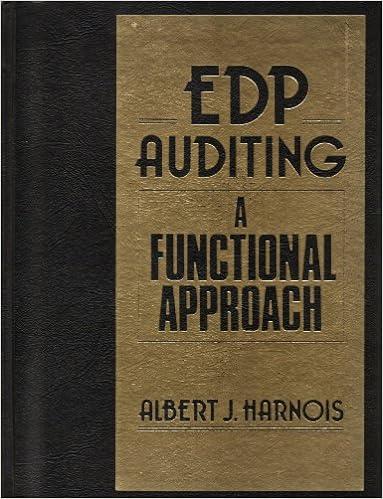Question
Question 41 On January 1, Sanford Corporation had 100,000 shares of $8 par value common stock outstanding. On June 17, the company declared a 9%
Question 41
On January 1, Sanford Corporation had 100,000 shares of $8 par value common stock outstanding. On June 17, the company declared a 9% stock dividend to stockholders of record on June 20. Market value of the stock was $37 on June 17. The stock was distributed on June 30. The entry to record the transaction of June 30 would include a
|
| A. | credit to Paid-in Capital in Excess of Par Value for $261,000. |
|
| B. | debit to Common Stock Dividends Distributable for $333,000. |
|
| C. | debit to Retained Earnings for $261,000. |
|
| D. | credit to Common Stock for $72,000. |
Question 42
A credit balance in retained earnings represents
|
| A. | a claim on specific assets of the corporation. |
|
| B. | the amount of stockholders' equity exempted from the stockholders' claim on total assets. |
|
| C. | the amount of cash retained in the business. |
|
| D. | a claim on the aggregate assets of the corporation |
Question 43
Rebel Inc. issued 4,800 shares of no-par common stock with a stated value of $1 per share. The market price of the stock on the date of issuance was $3 per share. The entry to record this transaction includes a
|
| A. | credit to Common Stock for $4,800. |
|
| B. | debit to Cash for $4,800. |
|
| C. | debit to Paid-in Capital in Excess of Par Value for $14,400. |
|
| D. | credit to Common Stock for $14,400. |
Question 44
On January 1, Swanson Corporation had 50,000 shares of $9 par value common stock outstanding. On March 17, the company declared a 14% stock dividend to stockholders of record on March 20. Market value of the stock was $16 on March 17. The entry to record the transaction of March 17 would include a
|
| A. | credit to Common Stock Dividends Distributable for $63,000 |
|
| B. | credit to Retained Earnings for $49,000. |
|
| C. | debit to Common Stock Dividends Distributable for $63,000. |
|
| D. | credit to Cash for $112,000. |
Question 45
On January 1, Swanson Corporation had 74,000 shares of $7 par value common stock outstanding. On March 17, the company declared a 9% stock dividend to stockholders of record on March 20. Market value of the stock was $13 on March 17. The stock was distributed on March 30. The entry to record the transaction of March 30 would include a
|
| A. | credit to Paid-in Capital in Excess of Par Value for $39,960 |
|
| B. | credit to Cash for $46,620. |
|
| C. | debit to Retained Earnings for $39,960. |
|
| D. | debit to Common Stock Dividends Distributable for $46,620. |
Question 46
A corporation purchases 10,000 shares of its own $10 par common stock for $15 per share, recording it at cost. What will be the effect on total stockholders' equity?
|
| A. | Decrease by $150,000 |
|
| B. | Increase by $150,000 |
|
| C. | Decrease by $100,000 |
|
| D. | Increase by $100,000 |
Question 47
If stock is issued for less than par value, the account
|
| A. | Paid-In Capital in Excess of Par Value is credited. |
|
| B. | Paid-In Capital in Excess of Par Value is debited if a credit balance exists in the account. |
|
| C. | Paid-In Capital in Excess of Par Value is debited if a debit balance exists in the account. |
|
| D. | Retained Earnings is credited. |
Question 48
The acquisition of treasury stock by a corporation
|
| A. | decreases its total assets and total stockholders' equity. |
|
| B. | requires that a gain or loss be recognized on the income statement. |
|
| C. | increases its total assets and total stockholders' equity. |
|
| D. | has no effect on total assets and total stockholders' equity. |
Question 49
Retro Company is authorized to issue 10,000 shares of 8%, $100 par value preferred stock and 500,000 shares of no-par common stock with a stated value of $1 per share. If Retro issues 5,000 shares of common stock to pay its recent attorney's bill of $20,000 for legal services on a land access dispute, which of the following would be the journal entry for Retro to record?
|
| A. |
| ||||||||||||
|
| B. |
| ||||||||||||
|
| C. |
| ||||||||||||
|
| D. |
|
Question 50
The two ways that a corporation can be classified by purpose are
|
| A. | general and limited. |
|
| B. | state and federal. |
|
| C. | publicly held and privately held. |
|
| D. | profit and not-for-profit. |
Step by Step Solution
There are 3 Steps involved in it
Step: 1

Get Instant Access to Expert-Tailored Solutions
See step-by-step solutions with expert insights and AI powered tools for academic success
Step: 2

Step: 3

Ace Your Homework with AI
Get the answers you need in no time with our AI-driven, step-by-step assistance
Get Started


